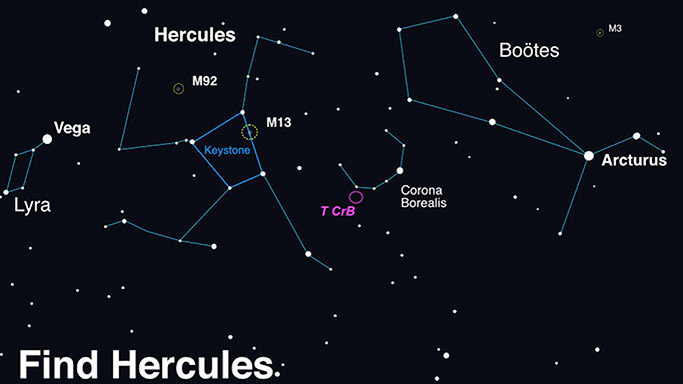 |
Scan between Vega and Arcturus to find Hercules during summer months, near the distinct pattern of Corona Borealis. Once you find its stars, use binoculars or a telescope to hunt down the globular clusters M13 (and a smaller globular cluster M92). Image created with assistance from Stellarium.org.
|
High in the summer sky, the constellation Hercules acts as a centerpiece for late-night stargazers. At the center of Hercules is the “Keystone,” a near-perfect square shape between the bright stars Vega and Arcturus that is easy to recognize and can serve as a guidepost for amazing sights. While not the brightest stars, the shape of the hero’s torso is overhead after sunset. Along the edge of this square, you can find a most magnificent jewel—the Great Globular Cluster of Hercules, also known as Messier 13. A pair of binoculars will show a faint, fuzzy patch, while a small telescope will resolve some of the stars.
Globular clusters are a tight ball of old stars, closer together than stars near us. These clusters orbit the center of our Milky Way like tight swarms of bees. One of the most famous short stories by Isaac Asimov, Nightfall, imagines a civilization living on a planet within one of these star clusters. Stars surround them so closely that it is always daytime except for once every millennium, when a special alignment occurs, plunging their planet into darkness. The sudden night reveals so many stars that it drives the inhabitants mad.
Back here on our home planet Earth, we are lucky enough to experience skies full of stars, a beautiful Moon, and regular eclipses. This summer will be extra special. Between Hercules and the ice-cream-cone-shaped Boötes constellation, you’ll find the small constellation Corona Borealis, shaped like the letter “C.” Astronomers around the world are watching T Coronae Borealis, also known as the “Blaze Star” in this constellation closely because it is predicted to go nova sometime this summer. There are only five known nova stars in the whole galaxy. It is a rare observable event, and you can take part in the fun!